The Corsair F-24 Mark I and Mark II still offer a good value today, even since many newer Corsair designs have entered the market. The late Ian Farrier (1947-2017) designed fast, trailerable trimarans for more than 40 years. A New Zealander, his first production success was the 18-foot Trailertri. His 19-foot Tramp was Boat-of-the-Year in Australia in 1981. In 1983 John Walton (of the Walmart family) founded Corsair to build high-performance multihulls, lured Farrier to Chula Vista, California, and the result was the very popular F-27. Almost 500 have been sold since it went into production in 1985. It has since been superseded by the F-28.
In 1991, Corsair added the F-24 Sport Cruiser. This abbreviated version of the F-27, with a starting price more than 30 percent lower than the F-27, was designed to be affordable.
While she remained sharp in the performance department, her accommodations were even more spartan. We spoke with Ian Farrier several times about anchoring and cruising; it was pretty clear that his heart was in racing and he even suggested we were probably better in tune with the needs and practicalities of small multi-hull cruising than he was. Still, he designed a cabin that can handily do both, if you can accept the compromises.
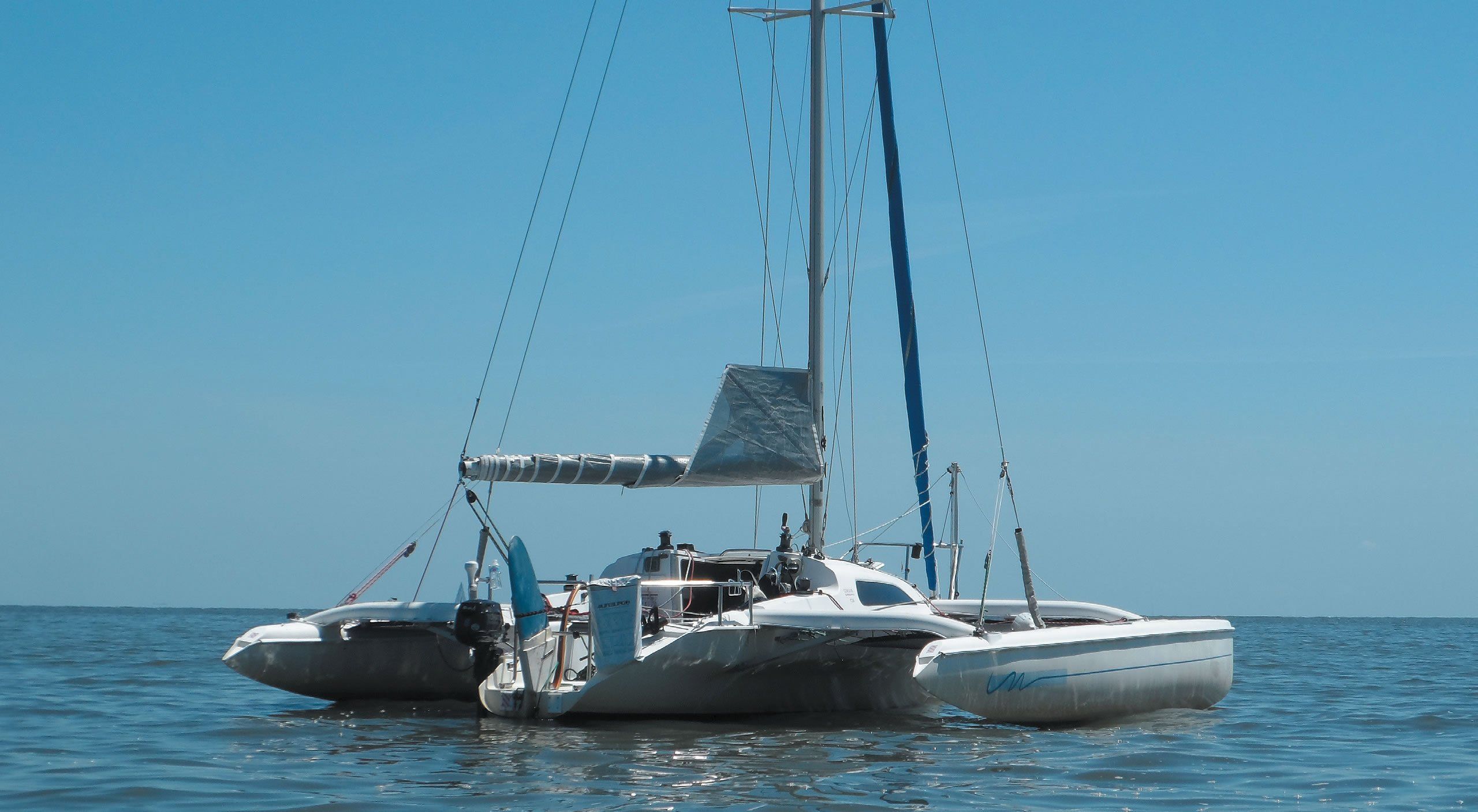
The author’s quick take on differences between the Mark I and the Mark II:
- The cockpit is longer in F-24 MKI (several feet) and a more usable cabin because no dagger board case.
- No damamge if you brush a sandbar with the MKI centerboard (I’ve done this MANY times). The clam cleat allows for smooth kick-up. Hit a sandbar at high speed with a daggerboard and something breaks.
- Different rudders. The MKI swings through the aft cockpit floor, the MK is transom hung.People have opinions, but I think the function is the same. Both swing up. The main problem is repair; if the MKI case has a problem it is DIY fiberglass work. If the MKII fails it is a bolt-on replacement.
- Lifting the CB part way improves balance under main-only because the board moves aft, moving the CLR aft, better under the sail. Lifting the DB does not do this.
- The MKII is faster. No CB case drag and a rotating mast.
- The MKII has a pop-top on the companionway. The MKI has a slider. Both work, but the slider is more trouble free and does not block the forward view when open.
Deck Plan

The deck layout is similar to the typical 24-foot monohull, except that it is wide-18 feet-with wing trampolines on both sides. In addition to providing stability, this gives lounging space in fair weather and greatly increases safety in rough weather. Though lacking railings and lifelines—other than a pulpit and wrap-around stern rail—it’s hard to fall off the F-24 if jacklines and tethers are used. A single large Lewmar foredeck hatch provides ample ventilation. The cockpit will easily seat six, but three is more comfortable for vigorous sailing.
The cockpit is equipped with four Lewmar 16 winches (the jib winches are one-speed self-tailers, the reacher winches are standard two-speed), two multi-line jammers and ten cam cleats. All essential sail controls, including halyards, are accessible from the cockpit, making for easy single-handed sailing.
The mainsail furls by winding around the boom; fast, convenient, and very gentle on the typical Mylar/carbon laminate sails. Reefing requires a quick trip to the mast to crank the boom around and attach the down haul, but that is it. The set up makes a vang impractical but few multihulls use them anyway, preferring to control the boom with the traveler.
The bow anchor locker holds two anchors and two rodes, so long as they are folding designs. Trimarans are best anchored using a bridle; the test boat uses a 20-foot Dyneema bridle that is retracted onto the wing nets when not in use.
Propulsion
The typical 6 horsepower outboard delivers about 5.3 knots at 1/3 throttle and about 6.5 knots wide open. The side mount provides decent performance in chop, pitching less than transom-mounted engines.

The portable fuel tank is protected from the sun and solar heating in an under-seat locker. It is wide is open for venting (but sealed from the cabin) and drains out through the open transom, safe and out of the way.
Interior
Since the emphasis was fast cruising and racing, storage and amenities are sparse. In the cabin there is storage behind the seat backs. The large rectangular top-opening lockers in the galley counter and under the seats can be fitted with hanging bags for easier access.

The head compartment has sufficient space for toilet paper and cleaning supplies. There is a large bottomless locker in the cockpit that also provides access to under cockpit areas. Lockers in the amas (outriggers) can hold light, bulky items.
There is sitting head room and ample seating for four on the starboard settee. An Origo alcohol stove and sink with rocker pump provide a minimal galley. A large cooler slides easily under the companionway. The forward V-berth is quite long, though a little pinched at the foot. The settee converts into a twin-sized bed using filler boards that slide neatly into storage slots under the companionway.

A portable head sits in a well behind a curtain, and is typically moved into the cockpit at bedtime for better privacy. Some owners rate the interior as poor, but most call it camping-out comfortable, suitable for an overnight or weekend.
Performance
Everyone wants to know how fast the little trimaran will go. To windward it points as well as most monohulls, thanks to a deep centerboard. Shell tack through less than 90 degrees if you pinch, though it’s faster if you bear off just a little. Keeping up with 40-foot cruisers is easy on any point of the sail, and you quickly chase them down on a reach.
With the wind free, expect to match true wind speed up to about 12 knots, after which you may reef or bleed power, depending on your mood. In lighter winds, pop out the reacher and you’ll get a whole new gear, easily exceeding wind speed.
In stronger winds, bear off until the true wind is on the quarter, and you’ll see 14 knots or more, although handling requires sharp attention if you haven’t reefed.

Compared to the Stiletto 27 (see PS July 2016), it is more weatherly, tacks faster, can safely handle more wind, but is slightly slower off the wind (though not as scary).
Upwind reefing begins at about 15 knots true for those who like fast sailing, but there is no reason not to reef a little earlier and enjoy more relaxed, but still spirited sailing. Maximum angle of heel is about 15 degrees.
With two reefs and the jib rolled up a little, she’ll take quite a lot of wind, perhaps 30 knots, without much excitement. Upwind in 20 knots is fun with the right reefs in, and that’s pretty good for a 24-foot boat. Farrier designed these conservatively, with windy conditions in mind. They are quite popular on San Francisco Bay, an area known for strong breezes.
Design
The Mark II was touted as the new and improved version of the Mark I. By replacing the centerboard with a daggerboard, weight was reduced, and a rotating mast increased power, making the Mark II noticeably faster. The Mark I has more usable cabin space, since the centerboard case is hidden inside the settee, and the Mark I cockpit is also several feet longer, a boon to fun daysailing.

The centerboard is also a blessing in shoal water, automatically pivoting up if it smells the bottom, instead of breaking things when you find a sandbar at 15 knots. The Mark I has a kick-up rudder fitted into a cassette, keeping it under the boat, while the Mark II has a transom hung rudder. The Mark I works as a day sailor and weekender, while racers prefer the Mark II.
Safety
As with any multihull, there is always the capsize canard. Sailed poorly, any sailboat can capsize, says Farrier. My designs are not immune to this. With over 1,000 Farriers now sailing, even a low 1 percent capsize ratio would mean 10 capsizes a year. However, the capsize rate actually appears to be averaging .03 percent.
Large ocean-going monohull yachts are foundering annually, sometimes with loss of life. The basic safety difference is that the monohulls ultimate stability is resting on the bottom, while the multihulls is floating on top.
Reef appropriately and the risk is truly small. F-27s have completed successful transpacific and transatlantic crossings, and even the first circumnavigation of the North Pole under sail. Finally, the F-24 can’t sink. Built-in foam flotation, light construction, and multiple crash tanks in the amas and foam-filled akas (cross beams) make this impossible.
The F-24’s main hull is fine, with a V-entry forward, U-sections mid-ships, and a relatively flat transom to damp pitching and provide lift for planing. Going to weather, most of the weight is on the amas, with fine V-sections that cut nicely through waves. Powering through short chop is not a strong suit among multihulls, but she has demonstrated considerable ability in choppy waters such as San Francisco Bay and the Chesapeake.
The heart of Farrier’s designs is the patented Farrier Folding System. Refined over the years, the mechanism allows the amas to fold-up, which reduces the F-24’s beam from 17 feet 11 inches to 8 feet 2 inches.
We kept our F-24 in a small boat marina for a time, folding after every sail; we did this while motoring in the channel, requiring only a few minutes of light effort by one person.
While the claim of trailering to sailing in 20 minutes may be true for seasoned crews that race every weekend, allow two hours for the transition if you do this only occasionally.
Although no single step is physically difficult for a single person, there are many steps and a second pair of hands makes for safer work. The engineering has proved very reliable, and now that the patents have expired, copies abound.
Construction
Performance multihulls built to their designed displacements are hardly ever built on production lines. Corsair has been the exception to that rule. Light weight is an essential if you want a cat or trimaran to sail up to its speed potential, but you’re not likely to achieve it with normal materials and common construction techniques.
Turning out an F-24 that weighs 1,800 pounds (1,650 pounds for the Mark II) is no simple matter. It involves almost 50 separate molded parts, considerably more than same-length monohulls.
Carbon fiber and Kevlar reinforcement, vacuum-bagging, double-biased fabrics, acrylic-modified epoxy resin, and NPG gelcoat are all elements you’d expect to see in a custom shop. They all go into the F-24.
Glass/resin control, published laminate schedules, a computer-generated production protocol, universally bonded top hat joints between hull and deck, barrier coats of vinyl ester resin, isopthalic resin throughout the rest of the laminate, and bulkheads tabbed in seven places to the hull makes for a light but sturdy boat.
The amas appear to be held in place by the anchor bolts inserted when unfolding, but the sailing forces are actually carried by strong pivot arms connecting the amas to anchor points near the waterline, anchored deep within the hull, and by compression blocks where the arms meet the hull at deck level.
After 20 years we’ve had a few minor issues related to failed bedding and damage to the balsa core, but nothing affecting the main structural elements.
Whether you’re downsizing from a cruising cat, or upsizing from the family Hobie, the F-24 offers the sports car of youthful dreams, on a budget. Is it worth paying three times as much as you would for a 24-foot mono-hull with more room? Not if you’re looking for cabin space and need an enclosed head. On the other hand, if fun sailing is the goal, the dollar-to-grin ratio is very high. Market demand is dependable and you will get your money back. It’s not the best beginner’s boat. You can’t just sheet-and-forget, and getting the best from her requires experience and attention. But if you have a beach cat or fast dinghy background, it’s a great way to gain weekender capability without losing any of the fun. If you need a little more comfort or more speed, look at the Corsair F-27. And if money is no object there’s a world of Farrier designs to choose from. Cruising in an F-24 is a tiny step above camping, but for the bare-bones cruiser who wants to cover some ground quickly, it fits the bill quite handily. 1. An alcohol stove and a small sink serve the micro-galley. Pros Cons This article was first published on 11 July 2018 and has been updated.
Sailboat Specifications Courtesy of Sailboatdata.com
Corsair F-24 Mk I Corsair F-24 Mk II
Hull Type: Centerboard Daggerboard
Rigging Type: Masthead Sloop Frac. Sloop (Rotating Spar)
LOA: 24.58 ft / 7.49 m 24.00 ft / 7.32 m
LWL: 18.08 ft / 5.51 m 23.58 ft / 7.19 m
S.A. (reported): 291.00 ft² / 27.03 m² 364.00 ft² / 33.82 m²
Beam: 8.00 ft / 2.44 m 17.92 ft / 5.46 m
Displacement: 5,920.00 lb / 2,685 kg 1,690.00 lb / 767 kg
Ballast: 3,000.00 lb / 1,361 kg 5.00 ft / 1.52 m
Max Draft: 3.42 ft / 1.04 m 1.00 ft / 0.30 m
Construction: FG FG
Ballast Type: Iron/Concrete NA
First Built: 1964 1996
Builder: Bristol Yachts/Sailstar Boats (USA) Corsair Marine (USA)
Designer: Paul Coble Ian Farrier
S.A. / Displ.: 14.27 41.14
Bal. / Displ.: 50.68 NA
Disp: / Len: 447.18 57.54
Comfort Ratio: 28.62
Capsize Screening Formula: 1.77
S#: 0.8
Hull Speed: 5.70 kn
Pounds/Inch Immersion: 516.81 pounds/inch
I: 30.30 ft / 9.24 m
J: 9.20 ft / 2.80 m
P: 26.40 ft / 8.05 m
E: 11.50 ft / 3.51 m
S.A. Fore: 139.38 ft² / 12.95 m²
S.A. Main: 151.80 ft² / 14.10 m²
S.A. Total (100% Fore + Main Triangles): 291.18 ft² / 27.05 m²
S.A./Displ. (calc.): 14.28
Est. Forestay Length: 31.67 ft / 9.65 m
Conclusions
2. The V-berth is tight, but the convertible settee in the main cabin makes a twin-sized bed.
3. The porta-potty sits under the V-berth. It is often moved to the cockpit at night while sleeping.
4. A folding table seats one for dining.
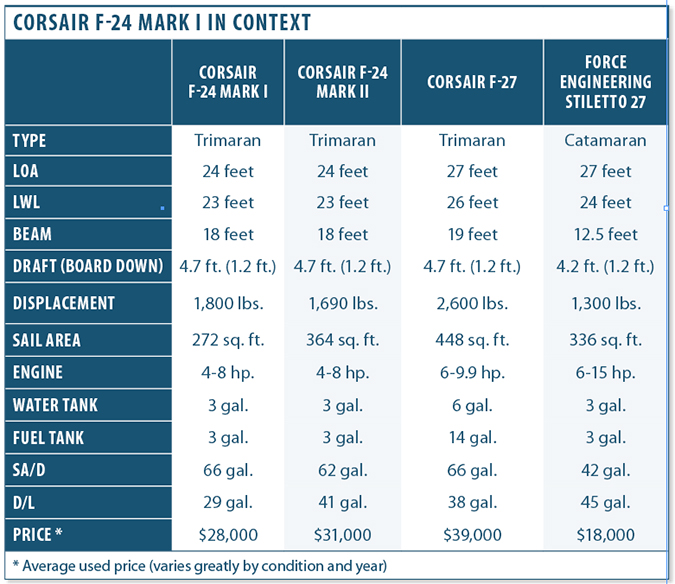
Market Scan Contact
2002 Corsair F-24 Mk II Windcraft Sails
$36,000 USD 404-905-3926
League City, Texas Yacht World












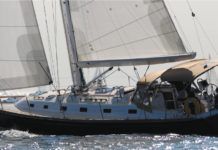



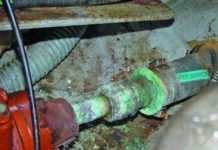







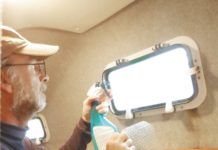








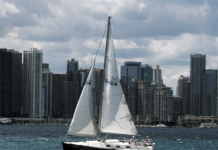

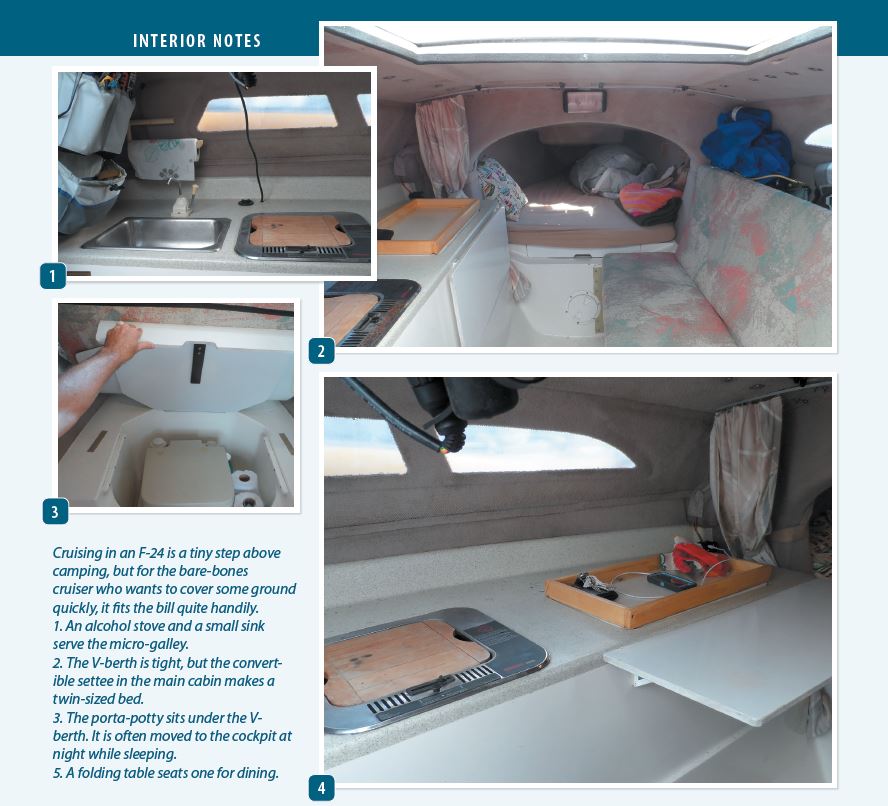
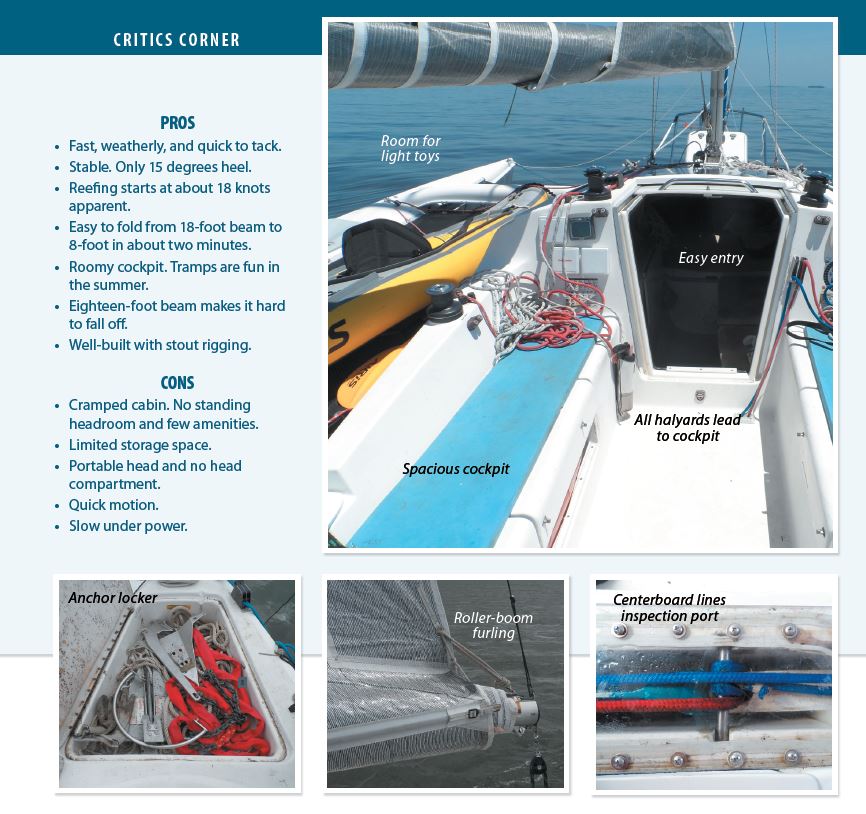





By far the most comprehensive review of the F-24 I was able to find online.
Many thanks for the write-up, very informative and helpful.
Lakeside Marine & Motorsports has been awarded Best of Forsyth Boat and Marine Service as well as Used Boat Sales. Please contact us for any kind of Boat work or Purchase.
The word is “superseded”. There is no such word as “superceded”. The etemology is not from words such as ‘precede’.
We owned a 2005 Sprint 750 which had the same center hull and floats as the 24 MkII but a taller rig, longer cockpit, and minimal cuddy cabin for over 16 years. With proper care, the boat is very reliable and aways super fun to sail. We never had an issue with the folding system and I routinely hoist launched and retrieved the boat by myself as well as raising and lowering the mast singlehanded. I loved the boat and I sold her for 75% of what I paid for her.
I only had two complaints during ownership. The first was that Corsair supplied the Sprint’s with an aluminum daggerboard and rudder as well as an aluminum rudder head. I replaced both with composite foils (they were identical in shape and plan) and Corsair later offered composite foils as an option or upgrade. If you sailed in salt water, the aluminum foils could have corrosion issues. The second was we had more gel coat cracks on the center hull than I think we should have and we had some gel coat voids in the float bows I had to address (but after about 12 years of use). Neither were a structural issue, only cosmetic. I never saw this issue happen on any of the boats after Corsair moved production to Vietnam and was bought by Seawind.
Great boats if your goal is a comfortable boat to sail with amazing ear-to-ear grin performance. The main safety caveat is to pay strict attention to sail reduction when the wind and sea state builds as mentioned above.
My favorite story to tell is a 100 mile long distance race we did in a mixed fleet in 5-10 knots of wind. We were 2nd boat to finish with first to finish being a custom Carkeek 40 with a pro crew that was only 45 minutes ahead of us (after 15-1/2 hours of sailing) and a J/111 being the 3rd to finish about 10 minutes behind us. The J/111 was steered by an Olympic silver medalist sailor. They were blown away at how fast our boat was, especially upwind.
Last I checked, Bob’s boat continued to sail well and win races into 2024. Plus, an awesome day sailer when just out for some fast fun!
At the beginning of my first full season with my F-24 I got caught with my spinnaker up in a surprise microburst on Long Island Sound. Suddenly I was looking down at the leeward ama making 9 kts. totally underwater. I had no time to release the halyard and the sheet overrode. The boat slowed, then capsized and turned turtle. As stable as she is right side up, she’s even more stable upside-down. Sea Tow cut the spinnaker loose, then pulled her sideways until she righted. The only losses, besides the spinnaker, was a winch handle, a jacket and my pride. We sailed her another fun 6 years without mishap and ultimately wound up with a P.S. Dana.
Two mistakes worth learning from (and I have made both of them, so no criticism is implied!):
a. Microbursts are not that unusual when there are squalls around, which I’m guessing there were. Going fast is thrilling, but a microburst can flatten any boat. After a few incidents, including pitch poling beach cats with chutes, I learned that conservative sailors take down canvas.
b. The most common cause of overrides is letting a sheet fly. Without a little bit of back tension the turns can flip over each other and jam. I’ve had that happen quite a few times when tacking and getting sloppy. You have to provide some back pressure, even when you want it out FAST. Overrides also occur when the lead angle to the winch is too high, but that should not have been the case this time.
Odds are nothing would have helped. Glad everything worked out!